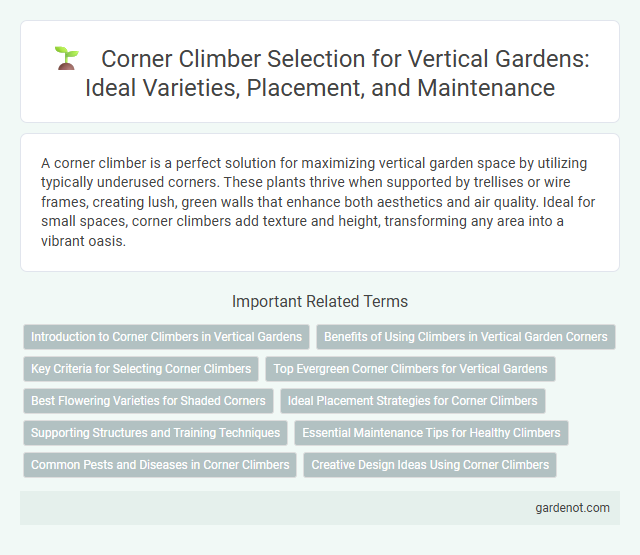A corner climber is a perfect solution for maximizing vertical garden space by utilizing typically underused corners. These plants thrive when supported by trellises or wire frames, creating lush, green walls that enhance both aesthetics and air quality. Ideal for small spaces, corner climbers add texture and height, transforming any area into a vibrant oasis.
Introduction to Corner Climbers in Vertical Gardens
Corner climbers are specialized plants designed to grow vertically along the edges of walls or garden corners, maximizing space in vertical gardens. These climbers exhibit strong attachment mechanisms such as tendrils, aerial roots, or adhesive pads, enabling them to securely anchor and ascend corner structures. Popular species for corner climbers include jasmine, ivy, and clematis, which provide lush greenery and vibrant blooms while enhancing the structural aesthetics of vertical garden installations.
Benefits of Using Climbers in Vertical Garden Corners
Corner climbers maximize space utilization by growing vertically along walls, creating lush green corners that enhance the visual appeal of vertical gardens. These plants improve air quality and provide natural insulation, reducing indoor temperatures and energy costs. Their dense foliage also offers privacy and serves as a natural habitat for beneficial insects in urban environments.
Key Criteria for Selecting Corner Climbers
Selecting corner climbers for a vertical garden requires evaluating growth habit, such as vigorous yet manageable vines that adhere well to angled surfaces. Prioritize species with dense foliage and seasonal blooms to maximize aesthetic appeal and privacy in tight corner spaces. Assess hardiness zones and maintenance needs to ensure long-term health and reduced pruning efforts in diverse climatic conditions.
Top Evergreen Corner Climbers for Vertical Gardens
Top evergreen corner climbers, such as English ivy (Hedera helix) and Star jasmine (Trachelospermum jasminoides), provide year-round greenery and dense coverage for vertical gardens. These climbers thrive in corner spaces, efficiently utilizing vertical surfaces while enhancing privacy and aesthetic appeal. Their robust growth and ability to cling to various substrates make them ideal choices for sustaining vibrant, low-maintenance corner green walls.
Best Flowering Varieties for Shaded Corners
The best flowering varieties for shaded corners in vertical gardens include Climbing Hydrangea, Clematis Armandii, and Bleeding Heart Vine, which thrive in low-light conditions while adding vibrant blooms. These corner climbers offer lush foliage combined with season-long flowers, making them ideal for enhancing shaded vertical spaces. Their adaptability to shade and vertical growth ensures a colorful and textured garden feature in less sun-exposed areas.
Ideal Placement Strategies for Corner Climbers
Corner climbers thrive when positioned in areas receiving partial to full sunlight, allowing their vines to maximize photosynthesis and growth. Placing these plants at the intersection of two walls or garden edges provides structural support for climbing, enhancing vertical coverage and aesthetic appeal. Optimal soil moisture and well-draining conditions further promote vigorous development and long-lasting greenery in vertical garden corners.
Supporting Structures and Training Techniques
Corner climbers thrive with sturdy supports such as trellises, wire frames, or wooden lattices designed to fit snugly into garden corners, maximizing vertical space. Training techniques include gently tying shoots to the support and regularly pruning to encourage upward growth and prevent overcrowding. Proper anchoring and consistent guidance ensure healthy, robust vines that transform corners into lush, green focal points.
Essential Maintenance Tips for Healthy Climbers
Corner climbers thrive with regular watering to keep soil consistently moist but not waterlogged, preventing root rot and encouraging steady growth. Pruning dead or yellowing leaves and trimming excessive stems promotes air circulation and directs energy to healthy parts of the plant. Supporting climbers with trellises or stakes helps maintain their vertical growth and prevents damage from heavy foliage or strong winds.
Common Pests and Diseases in Corner Climbers
Common pests affecting corner climbers include aphids, spider mites, and whiteflies, which feed on the plant's sap, causing leaf yellowing and stunted growth. Fungal diseases such as powdery mildew and root rot are prevalent in humid conditions, leading to white powdery spots on leaves and root decay, respectively. Regular inspection and appropriate pest management using organic insecticides and proper drainage can help maintain healthy corner climbers in vertical gardens.
Creative Design Ideas Using Corner Climbers
Corner climbers transform vertical garden spaces by maximizing unused angles with lush, cascading plants that enhance aesthetic appeal and air quality. Integrating diverse climbers such as ivy, jasmine, or clematis into corner frames or trellises creates visually dynamic green walls that save floor space. Utilizing modular corner trellis systems allows easy customization and seasonal plant rotation, boosting both creativity and functional greenery in urban garden designs.
Corner climber Infographic

 gardenot.com
gardenot.com